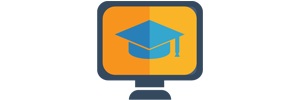
About MOOCs
Along with for-profit companies, massive open online courses are also offered by prominent colleges and universities worldwide. The roots of such programs likely began in the days of correspondence courses. These learning opportunities existed before the invention of the internet and involved mailing out lessons to students to complete and return for assessment. This method had many drawbacks, including poor learning outcomes, eventual lack of student interest and cheating. The advent of the internet allowed online classes to be more convenient and filled with aspects such as interactive learning, multimedia components and easier access to the instructor. The first MOOC was offered in 1994 by a professor named James O’Donnell from the University of Pennsylvania, and the topic was the works of St. Augustine of Hippo. More than 500 students signed up for this class. Currently, you’ll find millions of MOOC offerings on almost any topic you can imagine.
Difference Between MOOCs and Online Programs
First, it seems odd to refer to “traditional online learning” when online education is relatively new. Obviously, there could have been no widespread online learning without the Internet. That didn’t appear until the end of the 1960s. A few universities experimented with in-house linking of computers in a network so that students could access materials, but until computers became readily available to everyone, there was no system of virtual education. Open courses didn’t become available until the beginning of the 21st century. That means the online education “child” has been around for only a couple of decades. The question, “What is Coursera?” has been relevant for barely half that time. What is the difference between “traditional online learning” and MOOCs?
Access to Professors
According to the US News and World Report, one difference is that the traditional programs have greater access to professors. MOOC classes have video lectures by university educators, but assignments and “homework” are usually graded automatically or consist of “peer-to-peer reviews.” The exception to that is the paid degree or certificate program. Traditional programs are graded by educators who give feedback beyond a classmate review.
Group Assignments
Although this may be changing, most MOOC assignments are tests or essays. Some courses work better with the collaboration of peers, especially those courses leading to managerial positions.
Reputation
The article in the US News and World Report goes on to say that, because students expect to invest more time and money (which may signal commitment) into the traditional university online education, perspective employers view these credentials higher than the MOOC programs.
Interaction with Other Students
Although one aspect of a MOOC course is a forum, the participants may number in the thousands. Traditional online programs are closed systems, and so students get to know some peers on a “personal level.” That makes networking, a true benefit of traditional programs, possible.
History and Purpose
In 2012, Coursera was founded by two professors of computer science from Stanford. Since then, it’s become one of the most well-known names in MOOCs. The company doesn’t create its own educational coursework. It works with post-secondary institutions and government agencies to facilitate placing their current offerings online. In the beginning, the startup only worked with a sampling of the top colleges and universities to offer the most popular coursework. After this trial period, it now counts its partner institutions at over 100, with approximately 1000 course offerings. Partners are paid between 6 and 12 percent of the revenue earned from their courses, incentivizing their continued participation.
Course Formats
While there are a variety of course formats available, most classes run from between four to six weeks in duration. They run the gamut with regard to subject matter and offer video lessons, along with forum participation and various graded assessments on reading assignments. An honor code is signed by all students in an attempt to cut down on academic dishonesty. This is reinforced during exams by webcam use and biometric analysis of computer keystrokes in order to confirm the identities of students working toward a certificate. Along with online learning, students can also take classes through a mobile app.
Why People Take MOOC Courses
Some people want to grow their competency in professional skills. Computer programmers who only want expertise in Python, for example, but do not have the time or the inclination to take a full programming course can sign up for some Coursera courses in just the Python language. Plus, if they are doing it for their own benefit and not as a requirement of their positions, they probably won’t need the certification and may be able to learn the skill without cost. Someone beginning a career can get a jumpstart on qualifications through the courses. Many people attend community or junior college for two years and then transfer to a four-year school to finish their degrees because the two-year institutions are usually less expensive. That same concept applies to taking courses on the Coursera platform. Taking preparatory courses or partial degree programs and then transferring those credits to the university saves money and time. People also take the courses for personal fulfillment.
There are also people who want careers that typically require certification but not degrees. An example of this is the EMT specialization that includes courses in medications and emergency situations working with children and other subjects. Of course, people earning these certifications may still have to become licensed to practice.
Coursera Course Catalog
What is Coursera? A look through their online catalog gives a great picture of the platform. Although this article could not list all the Coursera courses, the catalog can be browsed at the leisure of perspective students. Some of the topics offered are Data Science, Business, Personal Development, Computer Science and Information Technology. Google and Amazon have courses in technology that provide certification for people who want careers in those, or similar, companies. There are courses in harnessing mental processes to achieve deeper learning. There are many different ways to study.
Guided Projects
Courses cover “job-relevant skills” that can be learned in two hours or less. The format, according to the Coursera website, is an “interactive experience guided by a subject matter expert.”
Free Courses
Many courses are completely free. Course materials are from universities around the globe. Assignments are “auto-graded.” For an additional fee, you receive more quizzes, extra projects and a “sharable electronic certificate” of completion.
Specialization
This is one level above individual courses. It is a series of related courses that allow learners to master a specific topic or skill. There are hands-on projects and a capstone project in the program. Some specializations contain only a few courses, but some may have 10, and take a year to finish.
Professional Certification Courses
There are many courses that allow learners to earn certifications, such as the EMT course offered through The University of Colorado through Denver Health Medical Center. The certificates earned are issued through the universities and not through Coursera and so , may be applicable toward credits.
Degrees
There are several degree programs offered through the platform that differ from traditional online programs in the ways discussed above. They are typically less expensive than traditional online programs and may take less time to complete but are still offered by respected universities.
Master Track
This program module is a portion of a master’s degree ( generally about 25 percent) that features live lectures and counts toward a degree. They are typically a semester to eight months in duration and constructed as a unit that cannot be taken as individual classes. People who complete a Master Track program can apply their credits toward a master’s degree.
What Is it Like to Take a Course?
Courses begin with an introduction or a syllabus. There is an overview of the materials that will be discussed. Learners also receive a set of videos lectures that average about 20 minutes each but can run several hours. Students take quizzes to make certain they understood the material. Coursera offers discussion prompts to encourage students to participate in the forums as well. There is an assignment, a problem set or a quiz that must be completed and submitted based upon the subject matter contained in the lectures and review transcript. The following week, the learner will receive his or her graded assignment as well as another set of lectures and another assignment. At the end of the course, there is a final exam that may contain 100 multiple-choice questions that can be completed over several days. The courses include note-taking apps and allow students to set goals that can be synced to their Google calendars. That means they will receive study and deadline reminders. Classes that are audited are self-paced but those with graded assignments will have submission deadlines. Students say that the Coursera option is structured and more like a true college program.
Students who have taken courses on the Coursera platform say the key to success in the program is commitment. Experts agree. The dropout rate for Coursera is 97 percent, according to insidehighered.com. The figures may be misleading because the accessibility of free online education leads some people to sign up “on a whim,” to just boost their understanding of classes they are taking at regular schools, or even as entertainment. Of 12,500 people who signed up for a bioelectricity course, only 350 took the final exam, and 5,000 never watched one lecture. Student goals make a difference. Again, student recommendations include taking only a few classes at a time, taking notes on the lectures and reviewing the lecture transcripts. Participating in online forums is important too.
What is the Cost?
Free courses on Coursera are free. Well, that is they are free unless you want feedback on your assignments, a mentor, extra course materials or a certificate. Students pay for those things.
Students taking individual courses for certification will pay a flat fee starting at $49. Professional certifications and specializations cost between $49 and $89 per month. Master Tracks start at $2,000, and online degree programs cost $10,000 plus.
Students can “subscribe” to Coursera Plus which gives them unlimited access to more than 3,000 courses for $399 a year. Coursera Plus excludes Master Tracks, degree programs and courses from some specific providers. There is also a Coursera Plus for Business that allows small companies to have unlimited access to many courses for about $400 per person per year, and Coursera Plus “Enterprise” which allots the same privileges to large corporations at a customized price. Coursera Plus for Government and College Communities gives qualifying institutions temporary free access to many Coursera classes.
That is not bad when you consider what universities charge. For instance, an MBA at University of Illinois earned through Coursera costs under $22,000. The same degree earned on campus has a price tag of $58,692. Of course, students give up the college experience, the availability of teachers and counselors and the immediacy of peer groups, but the degree itself is identical and awarded by the same prestigious institution. It is a little like buying a luxury car without the “bells and whistles.” Not all students need the extras.
Conclusion
Most of the learning opportunities on this platform remain free. However, if you wish to obtain a certificate for official purposes such as job promotion, you can opt to enroll in a paid program. Coursera offers educational opportunities from some of the most prestigious institutions at an affordable cost, which provides a wide array of benefits to students.
The platform offers a way to get education at a “bargain” price which includes finances and effort. It is an investment, and the key to getting a good “ return on the investment ( ROI)” is to bring commitment to the MOOC learning platform.
Related Resources:



